Ulefone are going to announce the Tiger very soon and, although we’re still not aware of most of the device’s specs, we get to know one more detail about the Ulefone Tiger, the 4000mAh “explosion-proof” battery!

After Samsung Note 7’s battery scandal, Chinese manufacturers are fighting on who gets the safest device on the market first (irony much?).
The people over at Ulefone get right to the point with their upcoming Ulefone Tiger. It will indeed feature the latest Sony Li-Polymer battery (with a capacity of 4000mAh) for an improved electric stability while charging and discharging.
There’s also going to be a dedicated chip to control the energy consumption so that unwanted power loss will be avoided.
Ulefone also promise to put a bigger effort on the software side, to improve efficiency and safety. In addition to that, they will use non-flammable high-strength materials for the battery’s enclosure. You can find some more info about the device in this article.






So disappointed, I was hoping this was a ulefone power 2… Damn! What a guy should do for a 6050+mah battery and a (at least) helio x20?! ?
ARGH i always want my smartphone has a built in grenade function like samsung !!!
For a long time I didn’t hear a bigger pile of bullshits on the one place.
Explosion proof battery? As much as dedicated integrated protection circuit that regulates charging & protects against overcharging and reducing the battery life cycle is a good thing it’s also a usual thing. Depending on how good used implementation is goes & warranty on the battery. So I really wonder how much is Sony giving a warranty on theirs? For instance Anker gives 16 months (& that’s a lot).
“There’s also going to be a dedicated chip to control the energy consumption so that unwanted power loss will be avoided.”
Don’t really see how this is possible. If any rail doesn’t get enough power in any moment the block (CPU, GPU, WiFi, GPS…) will fail to work & freeze leading to from unusability (until initialized [reset] again) to the complete system crash regarding the base ones like CPU and GPU…
“they will use non-flammable high-strength materials for the battery’s enclosure” standard the aluminum is used & it’s a perfect match as its hard but still flexible. I don’t know nor see a better one to use.
It’s possible either to use more durable aluminum or ticker battery shirt, this will allow it to resist to the bigger pressure level but also if driven to the edge would actually produce a stronger explosion. Using the more durable smartphone casings materials along with built-in batteries & literally no space for the battery to bread & expand is the main source of the problem. It is possible to make an pressure measurement sensor in to a battery & to connect it to the security valve (smal chamber with holes on the both sides in & out filled with pure alcohol) but if activated once it would controllable killed the battery burning it out slowly insted exploding. This would be a pricy to make & wouldn’t actually resolve the problem with the point that battery is built in & hard to replace. The older phones with removable back cover & batteries didn’t had the exploding problem as they had a space to bread & reaction whose also directed to the back (cover) so they ended up with blown as a balloon batteries usually.
Solution? Either going back to the removable back covers & batteries but I hardly think industry will choose that or construction of the battery as the module. If constructed as the module that can be placed & removed & only packed in its original shell (aluminum one) the problem of the explosion is solved as it again have space to breed. Actually there are numerous advantages of this approach; the capacity is not sacrificed it actually can even be expanded a little bit, if connecting mechanics is designed good to allow the parts separation under larger mechanical (or other) pressure it can also save a smartphone from sustaining the heavier damage lots of times (dropping the device for instance) as the battery is the heaviest part. It also brings back removabillity of the battery (that I bet most users would like). Sure it would cost more than the standard built in or removable batteries but only a little bit. & the back of the battery still can be coated with a thin layer of other material so that it isn’t cold or slippery if needed. Only downside would be that integrated charging regulation circuit would most be a good one as high battery temperature this way directly on your hand wouldn’t be something you want to experience.
Just my pair of daydreaming on topic for today.
The only one on the right path is lg, but I hope someone will follow… Just hoping for samsung to realize how many millions it would have saved if note 7 had a removable battery…
“For a long time I didn’t hear a bigger pile of bullshits on the one place”
You skipped reading Elephone articles ?